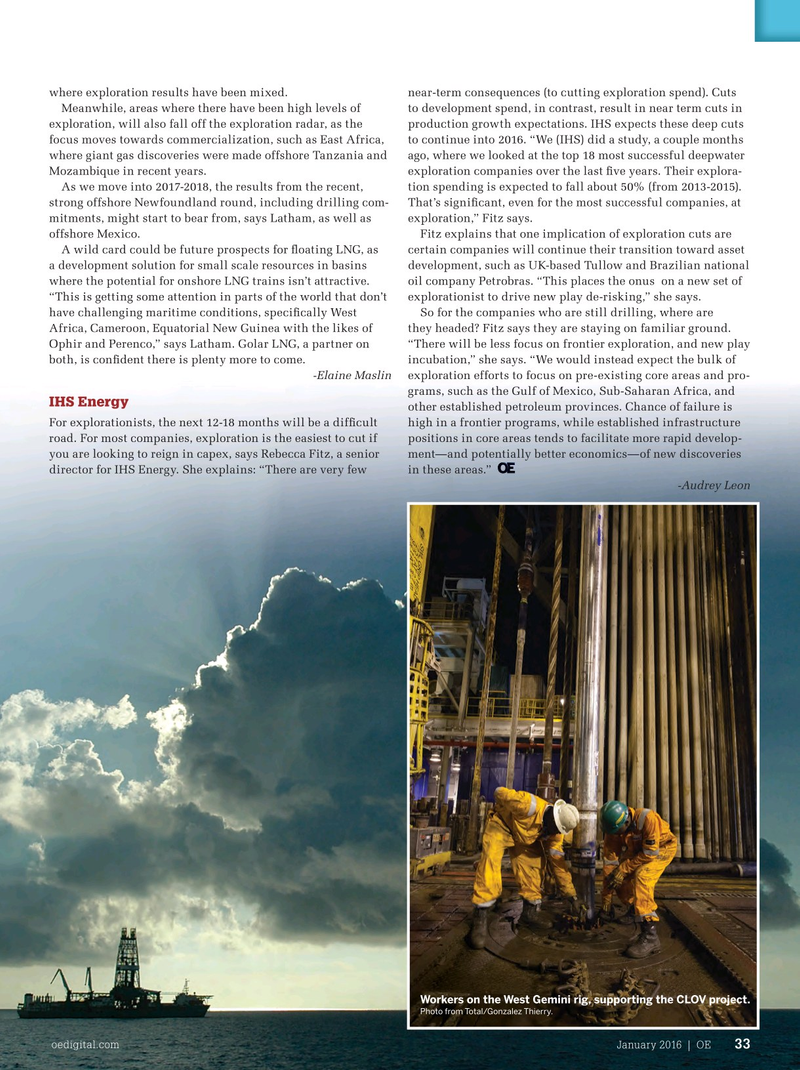
Page 31: of Offshore Engineer Magazine (Jan/Feb 2016)
Read this page in Pdf, Flash or Html5 edition of Jan/Feb 2016 Offshore Engineer Magazine
where exploration results have been mixed. near-term consequences (to cutting exploration spend). Cuts
Meanwhile, areas where there have been high levels of to development spend, in contrast, result in near term cuts in exploration, will also fall off the exploration radar, as the production growth expectations. IHS expects these deep cuts focus moves towards commercialization, such as East Africa, to continue into 2016. “We (IHS) did a study, a couple months where giant gas discoveries were made offshore Tanzania and ago, where we looked at the top 18 most successful deepwater
Mozambique in recent years. exploration companies over the last ? ve years. Their explora-
As we move into 2017-2018, the results from the recent, tion spending is expected to fall about 50% (from 2013-2015). strong offshore Newfoundland round, including drilling com- That’s signi? cant, even for the most successful companies, at mitments, might start to bear from, says Latham, as well as exploration,” Fitz says.
offshore Mexico. Fitz explains that one implication of exploration cuts are
A wild card could be future prospects for ? oating LNG, as certain companies will continue their transition toward asset a development solution for small scale resources in basins development, such as UK-based Tullow and Brazilian national where the potential for onshore LNG trains isn’t attractive. oil company Petrobras. “This places the onus on a new set of “This is getting some attention in parts of the world that don’t explorationist to drive new play de-risking,” she says.
have challenging maritime conditions, speci? cally West So for the companies who are still drilling, where are
Africa, Cameroon, Equatorial New Guinea with the likes of they headed? Fitz says they are staying on familiar ground.
Ophir and Perenco,” says Latham. Golar LNG, a partner on “There will be less focus on frontier exploration, and new play both, is con? dent there is plenty more to come. incubation,” she says. “We would instead expect the bulk of -Elaine Maslin exploration efforts to focus on pre-existing core areas and pro- grams, such as the Gulf of Mexico, Sub-Saharan Africa, and
IHS Energy other established petroleum provinces. Chance of failure is
For explorationists, the next 12-18 months will be a dif? cult high in a frontier programs, while established infrastructure road. For most companies, exploration is the easiest to cut if positions in core areas tends to facilitate more rapid develop- you are looking to reign in capex, says Rebecca Fitz, a senior ment—and potentially better economics—of new discoveries director for IHS Energy. She explains: “There are very few in these areas.” -Audrey Leon
Workers on the West Gemini rig, supporting the CLOV project.
Photo from Total/Gonzalez Thierry.
oedigital.com January 2016 | OE 33 032_OE0116_Feature3_Analyst.indd 33 12/24/15 1:22 AM

 30
30

 32
32